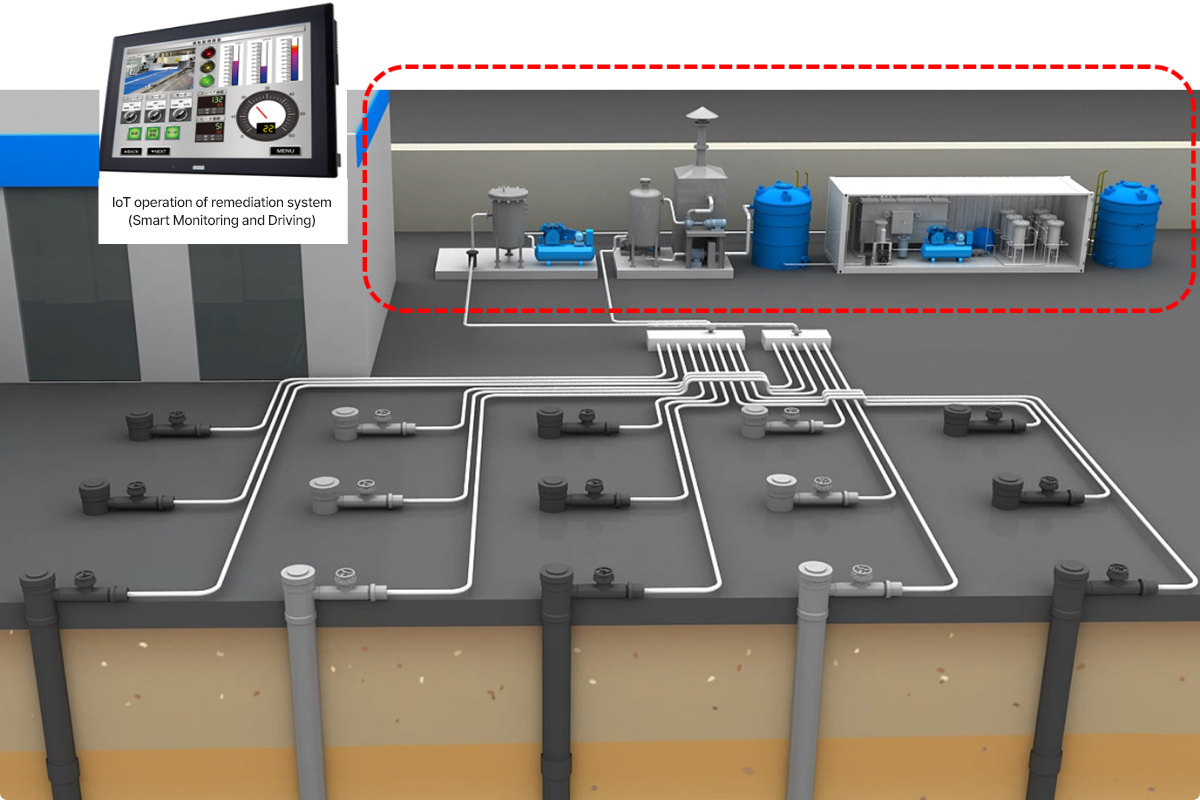In-situ
In-situ Remediation
How to remediate directly from contaminated sites
- Advantages
-
- • No need to excavate and move soil
- • Prevention of mixing with uncontaminated soil
- • Concomitant treatment of contaminated groundwater or soil
- • Oil-based hydrocarbons can be treated at a low cost
- Disadvantages
-
- • Usually time consuming
- • Difficult to check processing efficiency and measure processing process
- • Hard to be sure of consistent handling
- • Can increase the flow of contaminated substances
- • Pollutants can enter underground water
Public law and company-owned technology
MPE (Multi-Phase Extraction)
Technical Overview
The technology employs vacuum to simultaneously remove liquid and gaseous contaminants within low coefficient of infiltration or uneven subsurface conditions.
Technology Status
- • Remediation of subsurface petroleum contamination
- • Simultaneous remediation of soil and groundwater in contaminated areas unsuitable for excavation
- • Affordable technology that does not require post-processing facilities
- • Having a lot of subsurface remediation experience, introducing on-site customized technology
- • Deploying on-site optimization equipment to maximize operational efficiency
- • Development and patent application for mobile subsurface remediation equipment
Overview of MPE equipment operation

Field Application



Soil Flushing
Technical Overview
The technology involves injecting surfactants into soil pores to enhance the solubility of pollutants, followed by extracting water along with contaminants. The extracted water is then treated through post-treatment processes on the ground.
Technology Status
- • Stage 1: Simultaneous extraction and treatment of free oil, groundwater, and vapor using the MPE (Multi-Phase Extraction) method
- • Stage 2: Detachment of contaminants absorbed in the soil through Soil Flushing
- • Stage 3: Recover and treat the detached contaminants
- • Installation and Simultaneous Operation of Water Treatment Facilities
- • Enhancing remediation efficiency through concurrent implementation of In-Situ Chemical Oxidation method
Field Application


Chemical Oxidation
Technical Overview
The technique of directly injecting oxidants such as hydrogen peroxide and persulfates into groundwater and soil at contaminated sites to decompose pollutants.
Oxidants: Persulfate (PDS)

SGR - Core Technology : ① Persulfate (PDS) and Radical initiator (SGR-RI)
Technology Status
- • Radical initiator(SGR-RI) is increasing contaminant removal efficiency by inhibiting self-decomposition and facilitating radical conversion of oxidant Persulfate(PDS).
- • 30% improvement in oxidant self-decomposition reduction rate (utilization efficiency)
Collaborative Research and Development

Patent (No. 10-2215046)


Enhancing radical generation efficiency
using Radical initiator
→ Enhancement of oxidant utilization efficiency

Enhancing self-decomposition reduction rate
using Radical initiator
→ Enhancement oxidant delivery efficiency
SGR - Core Technology : ② Dual Packer System for Maximizing In-Situ Remediation Efficiency
Technology Status
- • Dual Packer AISCO system : a specialized in-situ remediation technology for soil remediation using persulfate (PDS) oxidant injection for chemical treatment of hydrocarbon contaminants.
- • The dual packer system maximizes the efficiency of contact with contaminants in the subsurface by directly injecting oxidants into the contaminated depth, exhibiting excellent horizontal transfer efficiency for the oxidant.
- • Selected as one of the Ministry of Environment's Top 20 Outstanding Technology Developments in 2021.
- • Broadcasted on YTN Tech Engineers in September 2020.
Collaborative Research and Development


The Operating Principle of the Dual Packer
Equipment for In Situ Remediation.
Dual Packer System composition

Dual Packer

Oxidant Injection Device
Patent (No. 10-2173993)

Patent (No. 10-2352211)

Field Application
-

(1) Injection/extraction remediation well installation
-

(2) Installation of the oxidant injection device
-

(3) Remediation wells groundwater level, LT check
-

(4) Dual packers, Single packers installed
-

(5) Oxidant injection
-

(6) Monitoring
Field monitoring system for In-situ remediation technology
Technology Status
- • Check the operation status of the soil remediation system through the field monitoring system (IoT) in real time.
- • Collection of information such as predictions for the remediation period

Bioslurping
Technical Overview
- • The application of a combined technology involving biological venting methods and vacuum extraction of mobile oils
- • Accelerating the aerobic biological decomposition in an unsaturated zone.
- • Suitable for the effective extraction and removal of residual mobile oils in the surficial layer and Capillary zone of groundwater.
- • Prevention of downward spread of contamination through groundwater.
Pump & Treat
Technical Overview
- • technology to purify contaminated underground water from the ground by pumping it.
- • Applicable to all types of dissolved contaminants.
- • have minimal impact on the environment of contaminated areas
- • Compatible with other remediation technologies